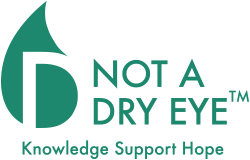Sometimes eye pain is used as a catch-all term to refer to any type of eye discomfort. But when we refer to pain, we mean the kind of pain that is pure pain, like that felt when you touch a severe bruise, or when a leg is broken. In this way, we differentiate pain from other forms of discomfort e.g.: burning or foreign body sensation.
Many different conditions related, or unrelated, to Dry Eye may cause eye pain including:
- Trauma — when something hits, scratches, or falls into the eye, and damages any part of the surface of the eye
- Foreign body in the eye
- Conjunctivochalasis
- One or more blocked or plugged meibomian glands
- Chalazion or stye
- Eye lashes that are budding through the surface of the skin
- Eye lashes that grow into the opposite eye lid
- Eye lashes that grow inwardly (entropion)
- Eye lashes that grow outwardly (ectropion)
- Muscle spasm in the eye lid
- Dry spot on the cornea
- Blinking, when there is excessive friction
- Real pain in one eye is felt in the opposite eye (sympathetic pain)
- Topical ophthalmic medications such as RESTASIS® (Cyclosporine)
- Reading without appropriate eyeglasses
- Infection of the eye socket
- Photophobia or eye discomfort caused by bright light
- Trigeminal neuralgia
- And many others
Many other diseases can cause eye pain including: the sudden increase in ocular pressure associated with glaucoma; and Tolosa-Hunt syndrome (headache and eye pain with inflammation at the back of the eye), among others.
Recent studies have attempted to link eye pain associated with dry eye to psychosomatic disorders, also called somatization, when symptoms don’t correspond with signs of disease. We are concerned that these studies may not be accurate because conditions that cause pain and discomfort, such as conjunctivochalasis and SLK, are often missed during exams. If the condition is undiagnosed, the patient’s pain may then thought to be of unknown non-physical origin, leading to a somatization diagnosis. If the psychosomatic disorder is treated and the underlying condition in the eyes is not, the patient will continue to suffer, while being labeled psychosomatic.
This report is one such example of an attempt to link unattributed Dry Eye pain with somatization disorder: Prevalence and risk factors of dry eye disease in a British female cohort.
Somatization definition: The normal, unconscious process by which psychological distress is expressed as physical symptoms. For example, a person with clinical depression may complain of stomach pains that prove to have no physical cause. Counseling can be helpful to overcome somatization
From: MedicineNet.com
Pain and other discomfort is usually rated on a scale of 1 – 10, with 10 being the worst pain ever felt. It is sometimes said that kidney stone pain is even worse than the pain of childbirth. And eye pain can be even worse than kidney stone pain.

